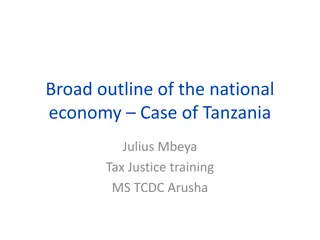The Future of Water Sector Governance in Tanzania: Challenges and Strategies
The presentation discusses key issues in water sector governance in Tanzania, such as managing water availability, population growth, climate change effects, and water demand projections. It highlights the depletion of water resources, the importance of system thinking, and the need for sustainable practices to address future challenges in water management.
Download Presentation

Please find below an Image/Link to download the presentation.
The content on the website is provided AS IS for your information and personal use only. It may not be sold, licensed, or shared on other websites without obtaining consent from the author.If you encounter any issues during the download, it is possible that the publisher has removed the file from their server.
You are allowed to download the files provided on this website for personal or commercial use, subject to the condition that they are used lawfully. All files are the property of their respective owners.
The content on the website is provided AS IS for your information and personal use only. It may not be sold, licensed, or shared on other websites without obtaining consent from the author.
E N D
Presentation Transcript
MINISTRY OF WATER The future of water sector governance in Tanzania Kitila Mkumbo (PhD) Permanent Secretary Ministry of Water Presentation at the 1st Maji Annual Scientific Conference 18 March 2019 1
Content Welcome note Water sector governance issues Water sector governance in Tanzania: Past, present and future outlook (Government perspective) Way forward 2
Welcome It is an important conference-an opportunity to reflect on the sciences and best practices on the water sector=water resource management and water service delivery The conference provides a great (indeed rare) avenue for public-academia-private-civil society interaction and partnership=system thinking 3
Water Sector Governance Issues Management of water availability vs. demand Depleting water resources amid increasing demand (se figures) Population growth Largest countries by population in 2050 five countries in Africa will be the world s top ten most populous nations-see East African excerpt Climate change and variability Combined effect: too much, too little, too polluted water 4
Renewable surface and ground water resources in Tanzania ? 130,037? ? ? 98,392? ? 76% ? 31,640? ? 24% Surface? Water? Resources? (MCM)? Ground? Water? Resources? (MCM)? TOTAL? WATER? RESOURCES? (MCM)? 5
Percapital freshwater available (cubic meters)-Tanzania 7,862 2,600 1,985 1,605 434 1962 2015 2025 2035 2050 6
Water Demand in Tanzania 57,560 52,152 39,645 40.1% 44.3% 30.5% 2015 2025 2035 7
The East African, March 4, 2019 The global population growth will be driven by a population explosion in East Africa (we shall still be having four babies per family for most of this century!) In 2100, five countries in Africa will be among the world's top 10 most populous nations. Nigeria will rank 3rd, with a population of 793 million; DR Congo will be 5th with 379 million; Tanzania will be 8th with 303 million; Ethiopia 9th with 250 million; and Uganda 10th with 213 million. Kenya will be in the next batch at 16th, with 142 million . 8
Water Sector Governance Focus Areas Increasing sustainable access to safe drinking water and sanitation services Having in place sound management, conservation and protection of freshwater resources Promoting cooperation on shared waters Strengthening/setting up water sector governance institutions and financing/infrastructure investment 9
Recent reforms in water sector governance Decentralised centralisation: Bringing together policies and people Increasing urban-rural partnership and linkages 10
Recent reforms in water sector governance New features Increased visibility and emphasis of sanitation services in rural areas Establishment of RUWASA: Manager of rural water projects and provider of water service delivery Semi-professionalisation of the rural water sector management: community based organisation 11
Intended Positive Consequences of Reforms in Water Sector Governance Effectiveness Efficiency Water Sector Governance Improving service delivery Achieving results with lowest Possible cost to society Engagement Ensuring inclusiveness and Participation of stakeholders 12
Way forward The future of water sector governance calls for: Balancing the water is used and finding new sources of water supply. The future is in the efficient use of water-this calls for technologies, education and training Priority in providing access to safe and adequate drinking and sanitation to those who do not have it as yet 13
Conclusion The best way to solve the world s water woes is to use less of it The Economist Saving water: Waste not, want not. 14























